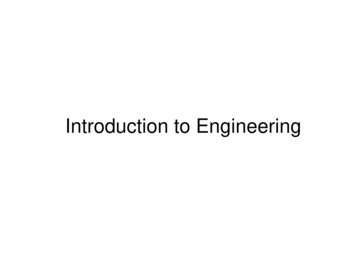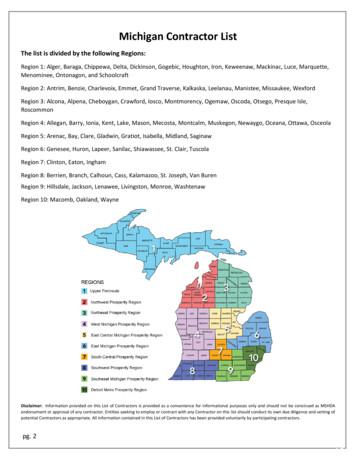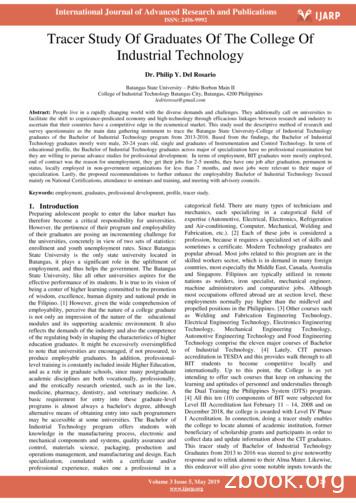Mechanical Engineering Technology
Mechanical Engineering TechnologyMECHANICAL ENGINEERINGTECHNOLOGYMechanical Engineering Technology (MET) is the component ofengineering that specializes in design and application. MET includes thebroad areas of mechanical design, mechanical power and manufacturing.MET is applied in mechatronics, robotics, automotive manufacturing,computer-aided design and engineering, computer-aided manufacturing,agricultural machinery and processing, mining, shipbuilding, spacecraft,electronics manufacturing, food processing, aircraft metals andplastics production—nearly the entire spectrum of the industry. In thepower areas, MET graduates are involved in vapor power cycles, gaspower cycles, air conditioning, fluid power and power transmission.Manufacturing areas involving MET graduates include tool design,cost evaluation and control, plant operations, production planning andmanufacturing methods.12. an ability to design systems, components, or processes meetingspecified needs for broadly-defined engineering problems appropriate tothe discipline;3. an ability to apply written, oral, and graphical communication inbroadly defined technical and non-technical environments; and an abilityto identify and use appropriate technical literature;4. an ability to conduct standard tests, measurements, and experimentsand to analyze and interpret the results to improve processes; and5. an ability to function effectively as a member as well as a leader ontechnical teams.An important element in MET is the use of laboratory experience asa teaching tool. The MET program has laboratories in mechatronics,fluid power, materials, fluid mechanics and applied thermal sciences,basic instrumentation, 3D printing, computer-aided design (CAD),Engineering (CAE), and manufacturing (CAM). A senior capstone designcourse, composed of student teams, integrates the knowledge and skillslearned during their course of study. The latest computer software isprovided and supported for the courses that MET students take. Whereappropriate, laboratories with modern computer data acquisition systemsand on-screen displays are available.Preparation for a specific industrial function is accomplished by selectingcourses that emphasize a given design area, such as fluid power,mechanical design, computer-aided design (CAD), power generation,and air conditioning and heating. Because the program focuses onthe application of engineering principles to the pragmatic solution ofproblems, graduates are immediately productive with minimal on-the-jobtraining, thus increasing their value to industry. Graduates of the METprogram are prepared to function in the areas of product design, testingand evaluation; product application and maintenance field engineering;and technical sales and liaison. Industries employing MET graduatesinclude manufacturing companies of all types (aircraft, automobile,compressor and turbine, fluid power manufacturers and others); energycompanies (such as natural gas, electrical power generation, and theoil and gas industries); and service companies (transportation industry,architecture and professional engineering firms, and those supporting theoil and gas industry).In addition to the required mechanical engineering technology courses,students are provided a solid foundation in algebra, trigonometry,calculus, physics, chemistry, computer science and entrepreneurship (asa minor).Companies utilizing the talents of MET graduates are diversified in theirproducts, as well as geographical location, thus providing a variety ofchoices in respect to both type of work and place of residence and indiverse industrial, governmental and educational institutions.Program Educational ObjectivesThe Mechanical Engineering Technology (MET) program at OklahomaState University focuses on preparing graduates so that they are ableto productively contribute at their workplace after a short introductoryperiod. A graduate from the OSU MET program should be able to:1. Employ the latest design and analysis tools in engineering andmanufacturing.2. Be a life-long learner through participation and membership inprofessional organizations, continuation of professional/graduatestudies, and/or self-study.3. Introduce new technologies and methods into their workplace tomaximize value to their employer.4. Work collaboratively in multi-disciplinary teams.5. Demonstrate professionalism in the workplace by using the higheststandards of ethics and personal integrity.Student OutcomesStudents graduating from the MET program are expected to achieve thefollowing outcomes (1-5):1. an ability to apply knowledge, techniques, skills and modern toolsof mathematics, science, engineering, and technology to solve broadlydefined engineering problems appropriate to the discipline;The Mechanical Engineering Technology program is accredited by theEngineering Technology Accreditation Commission of ABET, http://www.abet.org (http://www.abet.org/).Mechanical Engineering Technology (MET) is the component ofengineering that specializes in design and application. MET includes thebroad areas of mechanical design, mechanical power and manufacturing.MET is applied in mechatronics, robotics, automotive manufacturing,computer-aided design and engineering, computer-aided manufacturing,agricultural machinery and processing, mining, shipbuilding, spacecraft,electronics manufacturing, food processing, aircraft metals andplastics production—nearly the entire spectrum of the industry. In thepower areas, MET graduates are involved in vapor power cycles, gaspower cycles, air conditioning, fluid power and power transmission.Manufacturing areas involving MET graduates include tool design,cost evaluation and control, plant operations, production planning andmanufacturing methods.An important element in MET is the use of laboratory experience asa teaching tool. The MET program has laboratories in mechatronics,fluid power, materials, fluid mechanics and applied thermal sciences,basic instrumentation, 3D printing, computer-aided design (CAD),Engineering (CAE), and manufacturing (CAM). A senior capstone designcourse, composed of student teams, integrates the knowledge and skillslearned during their course of study. The latest computer software isprovided and supported for the courses that MET students take. Where
2Mechanical Engineering Technologyappropriate, laboratories with modern computer data acquisition systemsand on-screen displays are available.In addition to the required mechanical engineering technology courses,students are provided a solid foundation in algebra, trigonometry,calculus, physics, chemistry, computer science and entrepreneurship (asa minor).Program Educational ObjectivesThe Mechanical Engineering Technology (MET) program at OklahomaState University focuses on preparing graduates so that they are ableto productively contribute at their workplace after a short introductoryperiod. A graduate from the OSU MET program should be able to:1. Employ the latest design and analysis tools in engineering andmanufacturing.2. Be a life-long learner through participation and membership inprofessional organizations, continuation of professional/graduatestudies, and/or self-study.3. Introduce new technologies and methods into their workplace tomaximize value to their employer.4. Work collaboratively in multi-disciplinary teams.5. Demonstrate professionalism in the workplace by using the higheststandards of ethics and personal integrity.Student OutcomesStudents graduating from the MET program are expected to achieve thefollowing outcomes (1-5):1. an ability to apply knowledge, techniques, skills and modern tools ofmathematics, science, engineering, and technology to solve broadlydefined engineering problems appropriate to the discipline;2. an ability to design systems, components, or processes meetingspecified needs for broadly-defined engineering problems appropriateto the discipline;3. an ability to apply written, oral, and graphical communication inbroadly defined technical and non-technical environments; and anability to identify and use appropriate technical literature;4. an ability to conduct standard tests, measurements, and experimentsand to analyze and interpret the results to improve processes; and5. an ability to function effectively as a member as well as a leader ontechnical teams.Preparation for a specific industrial function is accomplished by selectingcourses that emphasize a given design area, such as fluid power,mechanical design, computer-aided design (CAD), power generation,and air conditioning and heating. Because the program focuses onthe application of engineering principles to the pragmatic solution ofproblems, graduates are immediately productive with minimal on-the-jobtraining, thus increasing their value to industry. Graduates of the METprogram are prepared to function in the areas of product design, testingand evaluation; product application and maintenance field engineering;and technical sales and liaison. Industries employing MET graduatesinclude manufacturing companies of all types (aircraft, automobile,compressor and turbine, fluid power manufacturers and others); energycompanies (such as natural gas, electrical power generation, and theoil and gas industries); and service companies (transportation industry,architecture and professional engineering firms, and those supporting theoil and gas industry).Companies utilizing the talents of MET graduates are diversified in theirproducts, as well as geographical location, thus providing a variety ofchoices in respect to both type of work and place of residence and indiverse industrial, governmental and educational institutions.The Mechanical Engineering Technology program is accredited by theEngineering Technology Accreditation Commission of ABET, http://www.abet.org (http://www.abet.org/).Mechanical Engineering Technology (MET) is the component ofengineering that specializes in design and application. MET includes thebroad areas of mechanical design, mechanical power and manufacturing.MET is applied in mechatronics, robotics, automotive manufacturing,computer-aided design and engineering, computer-aided manufacturing,agricultural machinery and processing, mining, shipbuilding, spacecraft,electronics manufacturing, food processing, aircraft metals andplastics production—nearly the entire spectrum of the industry. In thepower areas, MET graduates are involved in vapor power cycles, gaspower cycles, air conditioning, fluid power and power transmission.Manufacturing areas involving MET graduates include tool design,cost evaluation and control, plant operations, production planning andmanufacturing methods.An important element in MET is the use of laboratory experience asa teaching tool. The MET program has laboratories in mechatronics,fluid power, materials, fluid mechanics and applied thermal sciences,basic instrumentation, 3D printing, computer-aided design (CAD),Engineering (CAE), and manufacturing (CAM). A senior capstone designcourse, composed of student teams, integrates the knowledge and skillslearned during their course of study. The latest computer software isprovided and supported for the courses that MET students take. Whereappropriate, laboratories with modern computer data acquisition systemsand on-screen displays are available.In addition to the required mechanical engineering technology courses,students are provided a solid foundation in algebra, trigonometry,calculus, physics, chemistry, computer science and entrepreneurship (asa minor).Program Educational ObjectivesThe Mechanical Engineering Technology (MET) program at OklahomaState University focuses on preparing graduates so that they are ableto productively contribute at their workplace after a short introductoryperiod. A graduate from the OSU MET program should be able to:1. Employ the latest design and analysis tools in engineering andmanufacturing.2. Be a life-long learner through participation and membership inprofessional organizations, continuation of professional/graduatestudies, and/or self-study.3. Introduce new technologies and methods into their workplace tomaximize value to their employer.4. Work collaboratively in multi-disciplinary teams.5. Demonstrate professionalism in the workplace by using the higheststandards of ethics and personal integrity.Student OutcomesStudents graduating from the MET program are expected to achieve thefollowing outcomes (1-5):
Mechanical Engineering Technology1. an ability to apply knowledge, techniques, skills and modern tools ofmathematics, science, engineering, and technology to solve broadlydefined engineering problems appropriate to the discipline;2. an ability to design systems, components, or processes meetingspecified needs for broadly-defined engineering problems appropriateto the discipline;3. an ability to apply written, oral, and graphical communication inbroadly defined technical and non-technical environments; and anability to identify and use appropriate technical literature;4. an ability to conduct standard tests, measurements, and experimentsand to analyze and interpret the results to improve processes; and5. an ability to function effectively as a member as well as a leader ontechnical teams.Preparation for a specific industrial function is accomplished by selectingcourses that emphasize a given design area, such as fluid power,mechanical design, computer-aided design (CAD), power generation,and air conditioning and heating. Because the program focuses onthe application of engineering principles to the pragmatic solution ofproblems, graduates are immediately productive with minimal on-the-jobtraining, thus increasing their value to industry. Graduates of the METprogram are prepared to function in the areas of product design, testingand evaluation; product application and maintenance field engineering;and technical sales and liaison. Industries employing MET graduatesinclude manufacturing companies of all types (aircraft, automobile,compressor and turbine, fluid power manufacturers and others); energycompanies (such as natural gas, electrical power generation, and theoil and gas industries); and service companies (transportation industry,architecture and professional engineering firms, and those supporting theoil and gas industry).Companies utilizing the talents of MET graduates are diversified in theirproducts, as well as geographical location, thus providing a variety ofchoices in respect to both type of work and place of residence and indiverse industrial, governmental and educational institutions.The Mechanical Engineering Technology program is accredited by theEngineering Technology Accreditation Commission of ABET, http://www.abet.org (http://www.abet.org/).CoursesMET 1103 Introduction to Mechanical Engineering TechnologyDescription: Introduction to mechanical engineering technology,analytical techniques, and data presentation. Orientation to themechanical engineering technologist's profession. Previously offered asMPT 1103.Credit hours: 3Contact hours: Lecture: 2 Lab: 2 Contact: 4Levels: UndergraduateSchedule types: Lab, Lecture, Combined lecture and labDepartment/School: Engineering TechnologyMET 1121 Technical GraphicsPrerequisites: A grade of "C" or better in ENGR 1332 or ENGR 1322.Description: Visualization of 3-D objects, sketching, manual drafting ofengineering drawings to ANSI standards, interpreting typical industrialdrawings.Credit hours: 1Contact hours: Lab: 2 Contact: 2Levels: UndergraduateSchedule types: LabDepartment/School: Engineering Technology3MET 1123 Technical Drawing and Basic CADDescription: Sketching, manual drafting and CAD generation ofengineering drawings to ANSI standards. Interpreting typical industrialdrawings. Students with two years high school or one year practicalANSI drafting/CAD may substitute an advanced course in mechanicalengineering technology with consent of their advisers. Previously offeredas GENT 1153.Credit hours: 3Contact hours: Lecture: 3 Contact: 3Levels: UndergraduateSchedule types: LectureDepartment/School: Engineering TechnologyMET 2103 Industrial MaterialsPrerequisites: CHEM 1314 or CHEM 1215 or CHEM 1414.Description: A survey of the properties, characteristics and applicationsof metals, polymers, ceramics and other industrial materials. Terminology,concepts and principles involved in material selection, specificationand processing. Laboratory activities include data collection and reportgeneration, determination of material properties, and evaluation ofmaterial characteristics. Previously offered as GENT 1103.Credit hours: 3Contact hours: Lecture: 3 Contact: 3Levels: UndergraduateSchedule types: LectureDepartment/School: Engineering TechnologyMET 2223 Geometric Dimensioning and Tolerancing with ComputerAided DesignPrerequisites: A grade of “C” or better in (GENT 1153 or MET 1123) or agrade of “C” or better in (ENGR 1332 or equivalent) and MET 1121 (can beconcurrent enrollment in MET 1121).Description: Theory and application of Geometric Dimensioning andTolerancing (GD&T) technique. Creation and analysis of tolerancesfor manufacturing with advanced computer-aided design (CAD) andengineering drawings.Credit hours: 3Contact hours: Lecture: 3 Contact: 3Levels: UndergraduateSchedule types: LectureDepartment/School: Engineering TechnologyMET 2313 Fundamentals of Hydraulic Fluid PowerPrerequisites: A grade of "C" or better in ENSC 2113 or GENT 2323.Description: Basic fluid power concepts. Standard hydraulic symbols,component design and application, fluid power system considerations,design and operation. Previously offered as MPT 2313.Credit hours: 3Contact hours: Lecture: 2 Lab: 2 Contact: 4Levels: UndergraduateSchedule types: Lab, Lecture, Combined lecture and labDepartment/School: Engineering TechnologyMET 3003 DynamicsPrerequisites: A grade of "C" or better in GENT 2323 or ENSC 2113.Description: Plane motion of particles and rigid bodies. Forceacceleration, work-energy, and impulse-momentum principles. Graphicalanalysis, mechanisms and vibrations.Credit hours: 3Contact hours: Lecture: 3 Contact: 3Levels: UndergraduateSchedule types: LectureDepartment/School: Engineering Technology
4Mechanical Engineering TechnologyMET 3113 Basic InstrumentationPrerequisites: A grade of "C" or better in MATH 2123 or MATH 2144,and PHYS 1214 or PHYS 2114, and GENT 3323 or ENSC 2143, andENGR 2421.Description: Data analysis. Theory, operational characteristics andapplication of transducers for measurement of strain, force, velocity,acceleration, displacement, time, frequency, temperature, pressure.Previously offered as MPT 3114.Credit hours: 3Contact hours: Lecture: 2 Lab: 2 Contact: 4Levels: UndergraduateSchedule types: Lab, Lecture, Combined lecture and labDepartment/School: Engineering TechnologyMET 3223 Geometric Dimensioning and TolerancingPrerequisites: A grade of “C” or better in MET 1223 or MET 2223 orequivalent.Description: Theory and Application of Geometric Dimensioning andTolerancing (GD&T) technique. Creation and analysis of tolerances formanufacturing.Credit hours: 3Contact hours: Lecture: 3 Contact: 3Levels: UndergraduateSchedule types: LectureDepartment/School: Engineering TechnologyMET 3313 Applied Fluid MechanicsPrerequisites: A grade of "C" or better in (MATH 2123 or MATH 2144),(PHYS 1114 or PHYS 2014), and (GENT 2323 or ENSC 2113).Description: Practical analysis of fluid systems including static forces,the Bernoulli and general energy equations, laminar and turbulent flows,measurements of flow and pressure, lift and drag, pumps, and fans.Previously offered as MPT 3313.Credit hours: 3Contact hours: Lecture: 3 Contact: 3Levels: UndergraduateSchedule types: LectureDepartment/School: Engineering TechnologyMET 3343 Physical MetallurgyPrerequisites: A grade of "C" or better in (CHEM 1215 or CHEM 1314 orCHEM 14114 or CHEM 1515).Description: Analysis and evaluation of the properties of metalscommonly used in product design. Property change caused by hot andcold working, and by heat treatment. Laboratory activiti
Mechanical Engineering Technology 1 MECHANICAL ENGINEERING TECHNOLOGY Mechanical Engineering Technology (MET) is the component of . electronics manufacturing, food processing, aircraft metals and . Preparation for a specific
Materials Science and Engineering, Mechanical Engineering, Production Engineering, Chemical Engineering, Textile Engineering, Nuclear Engineering, Electrical Engineering, Civil Engineering, other related Engineering discipline Energy Resources Engineering (ERE) The students’ academic background should be: Mechanical Power Engineering, Energy .
Mechanical Engineering Aerodynamic Design of Vehicles Compute Aided Analysis & Design Analysis & Design. Mechanical Engineering Wind Energy Fuel Cell Energy. Mechanical Engineering UAV Space Shuttle Air & Space. Mechanical Engineering Robotics Utilities Systems. Civil Engineering Foundation Structural Analysis Analysis & Design. Civil Engineering Bridge Skyscraper Tunnel Construction . Civil .
Mechanical Engineering 1 Mechanical Engineering The Department of Mechanical Engineering offers three graduate degree programs: the Master of Engineering (M.Eng), the Master of Science (M.S.), and the Doctor of Philosophy (Ph.D.). Master of Engineering (M.Eng) This accelerated Masters of Engineering Program has been designed
mechanical engineering, Railway mechanical engineering, Welding and welded structures, Engineering of biotechnical systems, Industrial engineering, Information technologies, Motor vehicles, Internal combustion engines, Food industry engineering, Production engineering, Process engineering and environment protection, Weapon systems, Thermal power
The Mechanical Foundation Series is a compulsory basic course for mechanical majors. It covers a wide range of courses, including mechanical drawing, mechanical principles, mechanical design, mechanical manufacturing foundation, engineering materials and tolerance technology measurement [1]. It is a learning
Mechanical Contractor Redmon Heating & Cooling Grandville (616) 534-9330 Mechanical Contractor D.K.S. Mechanical, Inc. Marne (616) 677-6001 Mechanical Contractor AirFlow Mechanical Services LLC Wyoming (616) 752-0320 Mechanical Contractor Van Antwerp's Mechanical, Inc. Holland (616) 772-1112 Mechanical Contractor Grand Rapids Heating and .
as Welding and Fabrication Engineering Technology, Electrical Engineering Technology, Electronics Engineering Technology, Mechanical Engineering Technology, Automotive Engineering Technology and Food Engineering Technology comprise the eleven major courses of Bachelor of
language classes (and be honest, did you actually learn all that much in there?). There are now many different online lessons and tutorials to help you become proficient in the language of your choice. FluentU stands out among language learning websites, thanks to the huge range of learning opportunities it provides. 5 The Complete Guide to Foreign Language Immersion. FluentU takes real-world .























